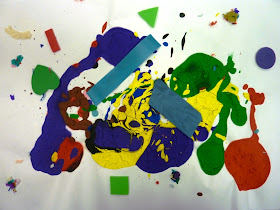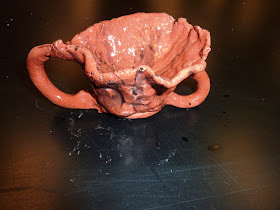I introduced my kindergarteners to Jackson Pollock by showing them this student-made video that I found on YouTube. They were intrigued by the fact that he painted with his canvas on the floor and that he got his paint all over everything.
 I bought ketchup and mustard squeeze bottles at the dollar store and filled each bottle with a different color of tempera paint. I added a little bit of sand to each bottle and mixed it up.
I bought ketchup and mustard squeeze bottles at the dollar store and filled each bottle with a different color of tempera paint. I added a little bit of sand to each bottle and mixed it up. I took the students into the courtyard right outside of my art room and showed them how they were going to lay their paper on the floor and squirt paint onto their paper. Then I demonstrated how to pick up their paper with 2 hands, so that they didn't get themselves completely covered in paint (not sure that mom would appreciate us completely embodying the Pollock style). They then would move on to another color and squirt that onto their paper, repeating the entire process until they had every color on their paper.
I took the students into the courtyard right outside of my art room and showed them how they were going to lay their paper on the floor and squirt paint onto their paper. Then I demonstrated how to pick up their paper with 2 hands, so that they didn't get themselves completely covered in paint (not sure that mom would appreciate us completely embodying the Pollock style). They then would move on to another color and squirt that onto their paper, repeating the entire process until they had every color on their paper.The interesting thing, was how long some of the paintings took to dry! I hadn't thought of this and there were a couple of classes that really loaded their papers with paint and their papers took 3 days to fully dry!
 For the next class, they added even more textures to their paintings. I gave each table a variety of ribbons, foam shapes and confetti and showed them how to glue it onto their paintings, trying to spread everything around the entire page.
For the next class, they added even more textures to their paintings. I gave each table a variety of ribbons, foam shapes and confetti and showed them how to glue it onto their paintings, trying to spread everything around the entire page.











































